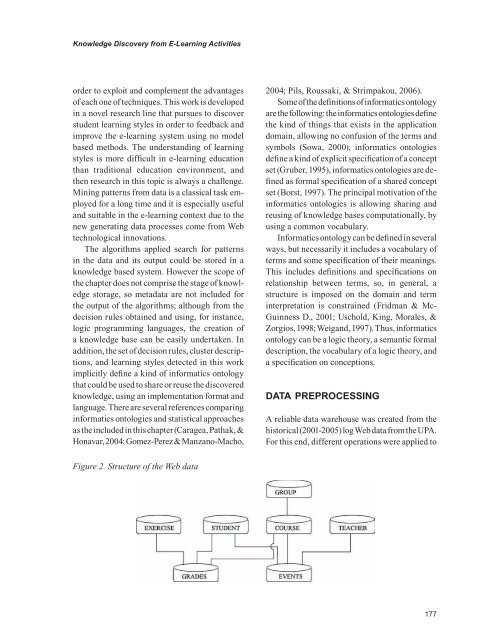Advances in E-learning-Experiences and Methodologies
Create successful ePaper yourself
Turn your PDF publications into a flip-book with our unique Google optimized e-Paper software.
Knowledge Discovery from E-Learn<strong>in</strong>g Activities<br />
order to exploit <strong>and</strong> complement the advantages<br />
of each one of techniques. This work is developed<br />
<strong>in</strong> a novel research l<strong>in</strong>e that pursues to discover<br />
student learn<strong>in</strong>g styles <strong>in</strong> order to feedback <strong>and</strong><br />
improve the e-learn<strong>in</strong>g system us<strong>in</strong>g no model<br />
based methods. The underst<strong>and</strong><strong>in</strong>g of learn<strong>in</strong>g<br />
styles is more difficult <strong>in</strong> e-learn<strong>in</strong>g education<br />
than traditional education environment, <strong>and</strong><br />
then research <strong>in</strong> this topic is always a challenge.<br />
M<strong>in</strong><strong>in</strong>g patterns from data is a classical task employed<br />
for a long time <strong>and</strong> it is especially useful<br />
<strong>and</strong> suitable <strong>in</strong> the e-learn<strong>in</strong>g context due to the<br />
new generat<strong>in</strong>g data processes come from Web<br />
technological <strong>in</strong>novations.<br />
The algorithms applied search for patterns<br />
<strong>in</strong> the data <strong>and</strong> its output could be stored <strong>in</strong> a<br />
knowledge based system. However the scope of<br />
the chapter does not comprise the stage of knowledge<br />
storage, so metadata are not <strong>in</strong>cluded for<br />
the output of the algorithms; although from the<br />
decision rules obta<strong>in</strong>ed <strong>and</strong> us<strong>in</strong>g, for <strong>in</strong>stance,<br />
logic programm<strong>in</strong>g languages, the creation of<br />
a knowledge base can be easily undertaken. In<br />
addition, the set of decision rules, cluster descriptions,<br />
<strong>and</strong> learn<strong>in</strong>g styles detected <strong>in</strong> this work<br />
implicitly def<strong>in</strong>e a k<strong>in</strong>d of <strong>in</strong>formatics ontology<br />
that could be used to share or reuse the discovered<br />
knowledge, us<strong>in</strong>g an implementation format <strong>and</strong><br />
language. There are several references compar<strong>in</strong>g<br />
<strong>in</strong>formatics ontologies <strong>and</strong> statistical approaches<br />
as the <strong>in</strong>cluded <strong>in</strong> this chapter (Caragea, Pathak, &<br />
Honavar, 2004; Gomez-Perez & Manzano-Macho,<br />
2004; Pils, Roussaki, & Strimpakou, 2006).<br />
Some of the def<strong>in</strong>itions of <strong>in</strong>formatics ontology<br />
are the follow<strong>in</strong>g: the <strong>in</strong>formatics ontologies def<strong>in</strong>e<br />
the k<strong>in</strong>d of th<strong>in</strong>gs that exists <strong>in</strong> the application<br />
doma<strong>in</strong>, allow<strong>in</strong>g no confusion of the terms <strong>and</strong><br />
symbols (Sowa, 2000), <strong>in</strong>formatics ontologies<br />
def<strong>in</strong>e a k<strong>in</strong>d of explicit specification of a concept<br />
set (Gruber, 1995), <strong>in</strong>formatics ontologies are def<strong>in</strong>ed<br />
as formal specification of a shared concept<br />
set (Borst, 1997). The pr<strong>in</strong>cipal motivation of the<br />
<strong>in</strong>formatics ontologies is allow<strong>in</strong>g shar<strong>in</strong>g <strong>and</strong><br />
reus<strong>in</strong>g of knowledge bases computationally, by<br />
us<strong>in</strong>g a common vocabulary.<br />
Informatics ontology can be def<strong>in</strong>ed <strong>in</strong> several<br />
ways, but necessarily it <strong>in</strong>cludes a vocabulary of<br />
terms <strong>and</strong> some specification of their mean<strong>in</strong>gs.<br />
This <strong>in</strong>cludes def<strong>in</strong>itions <strong>and</strong> specifications on<br />
relationship between terms, so, <strong>in</strong> general, a<br />
structure is imposed on the doma<strong>in</strong> <strong>and</strong> term<br />
<strong>in</strong>terpretation is constra<strong>in</strong>ed (Fridman & Mc-<br />
Gu<strong>in</strong>ness D., 2001; Uschold, K<strong>in</strong>g, Morales, &<br />
Zorgios, 1998; Weig<strong>and</strong>, 1997). Thus, <strong>in</strong>formatics<br />
ontology can be a logic theory, a semantic formal<br />
description, the vocabulary of a logic theory, <strong>and</strong><br />
a specification on conceptions.<br />
dAtA PreProcessIng<br />
A reliable data warehouse was created from the<br />
historical (2001-2005) log Web data from the UPA.<br />
For this end, different operations were applied to<br />
Figure 2. Structure of the Web data


